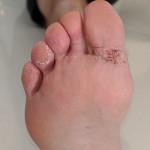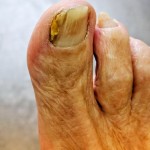Tinea & Fungal Nails
Tinea
Tinea is a skin condition caused by a fungal infection. It can occur on numerous areas of the body, but on the feet is a common location. It is sometimes called Athlete’s foot because it regularly occurs in athletes who share change and shower facilities. Tinea is extremely common and seen at Rockingham Podiatry all the time. Sometimes patients are unaware they have the condition. Tinea thrives in a warm, moist, dark environment so on the feet is ideal.
Tinea is highly contagious. It can be spread by direct skin to skin contact. It can also be spread through contact with infected clothes, towels, and floors. As mentioned showers and change room floors are a common place of initial contact. Shower floors and the floors in change rooms of gyms, caravan parks, swimming pools, hostels etc are perfect locations for initial contact of a fungal infection. They are high traffic places which may not be thoroughly and regularly cleaned. At these places there is also more exposure to a demographic of people who are likely to carry the infection.
Tinea can have numerous and varied signs and symptoms. Tinea can occur anywhere on the feet, but around the toes and between the webbing is the most common sites. It is often itchy and this is how many people first become aware of tinea. It is often itchy in bed at night when the feet get warm. It may appear as a red, scaly rash. There may be small or large blisters. The skin may peel, split or crack. The site may become painful when they open up and form like a sore or ulcer. This can be a particular problem for runners or people walking distances over continuous days when they become raw and painful.
 Tinea
Tinea
As always prevention is better than a cure. If you are going to use shared facilities wearing something on your feet. Cheap thongs which are light are ideal as they can be washed, left to dry and are easy to pack. Crocs or similar are also good.
Treatment of tinea is important because it can spread to other areas of the body and can be passed on to other people. Around the toes it may spread from the skin to the nails which then becomes a more challenging location to treat as the nails grow slowly. Skin renews itself more quickly than nails, so is faster to treat.
The infected site needs to be cleaned regularly and being left to the open air is beneficial. Footwear should be opened up if possible and left to dry. Footwear can also be treated with a talc like antifungal powder shaken lightly inside. Topical application of antifungal creams, lotions or sprays is the usual form of treatment. You do not require a prescription for topical antifungals so speak to your Pharmacist who can give you some advice.
Tinea spores can survive for months on the skin so it is advised to keep using the topical treatment for at least 2 weeks after the area looks like it has settled down. The infected area should settle down in a couple of weeks. If the tinea does not resolve then swapping to another type of antifungal is advised as different applications have different active ingredients. In severe or stubborn cases your doctor may prescribe a course of antifungal tablets which will treat the condition systemically.
Fungal Nails
As the term implies it is also possible to have a fungal infection of the nails. This is again very common and most days at Rockingham Podiatry we see a patient who has a fungal infection of their nail/s. As people age or due to chronic shoe pressure from shoes, toenails may become thick, uneven and discoloured. This is very common. Just because a nail looks unusual it does not mean it has a fungal infection.
Most nails can be assessed visually and sometimes by odour. Occasionally it is difficult to determine if the nail is fungal. In these cases a small sample may be collected and sent to pathology for diagnosis.
With a fungal infection, part or all of the nail plate may be infected, and multiple nails may be involved. The nail plate may appear discoloured (yellow, brown or white), thickened and crumbly in areas where the nail may split. Nails may present with some of the said appearance without the presence of a fungal infection. An accurate diagnosis is essential before a suitable form of treatment begins. You do not want to waste time and money treating a discoloured nail that is not fungal.
 Fungal Nail
Fungal Nail
Like tinea fungal nail infections can be treated topically. Again the antifungal agent can be obtained without prescription from a pharmacy. There are numerous products available and they take the form of a polish, tincture or lacquer which is applied to the nail, normally with a small brush supplied. A large toenail takes approximately 1 year to grow in the average person. This means treating an infected nail is a slow process. Fungal nail infections can be stubborn to treat and in my experience the topical approach to the treatment is often unsuccessful. The nail can be treated with a systemic agent prescribed by your doctor, which is more successful and works faster. A positive pathology culture is required in Australia to have the course of tablets subsidised under the PBS. Your GP will also assess whether you are suitable to take the oral medication.
If you are uncertain what you are dealing with regards to a condition of your nails or feet book an appointment online or phone Rockingham Podiatry on 9592 1068. We can assess your condition and discuss treatment options available.